
Physiotherapy improves the effectiveness of drugs, consolidates the results of treatment and contributes to the restoration of tissue and cellular immunity of the prostate.In medical institutions, procedures are performed using professional devices with various modes of operation..At home, the device for the treatment of prostatitis can be used only with the permission and under the periodic supervision of a doctor.
Types of devices and principles of their operation
Types of physiotherapy devices used to treat prostatitis:
- Electromyostimulant (causes muscle contraction);
- Electromagnetic;
- Vibration stimulation (massage);
- Ultrasonic;
- Laser.
The most functional and effective devices are those with combined action.
Contraindicationsto hardware physiotherapy for prostatitis:
- Individual intolerance. The patient may experience groin pain, rashes, and skin irritation.
- Malignant tumor.
- Active tuberculosis.
- Blood clotting disorders.
- Stones in the prostate (chalcolithic prostatitis).
- The presence of foci of suppuration (focal purulent prostatitis).
In acute prostatitis, heating of the gland is unacceptable, so devices that apply heat are not used.
Electrical stimulation devices
Electrical stimulation of the muscles is performed by influencing the motor nerves with pulsed currents passing between the electrodes. The impulses are similar to those that the body itself generates to irritate nerve fibers.Therapeutic effect for prostatitis:
- Local blood circulation and metabolic processes are activated;
- Lymph outflow improves, venous stagnation is eliminated;
- The regeneration of damaged tissues is stimulated;
- The sensitivity of the nerve endings is regulated;
- Prostate swelling subsides;
- The muscular structure of the pelvic floor is strengthened;
- In the prostatic tissue, the processes of atrophy and sclerosis, caused by chronic inflammation, are inhibited;
- Benign neoplasms with a diameter of up to 0. 5 cm are destroyed.
When carrying out the procedure, two points are important: the correct position of the electrodes and the intensity of the current.
Various types of electrical stimulation of the prostate
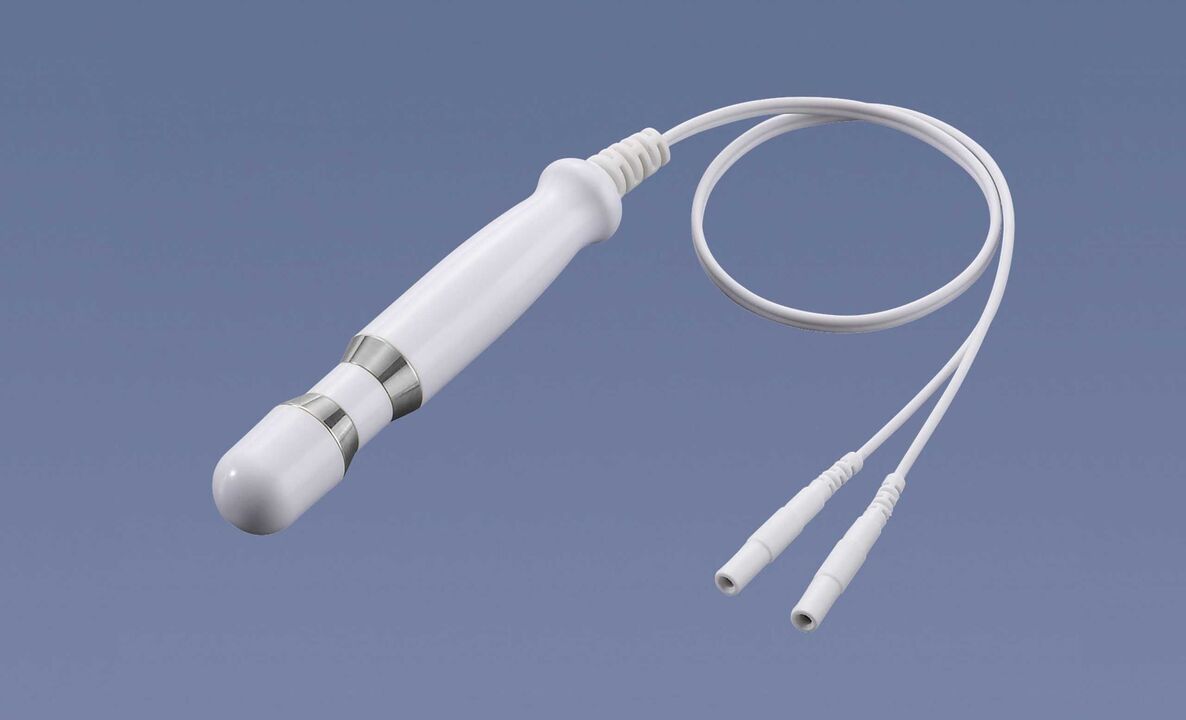
Prostate stimulation is performed in three ways(depending on attachments included with your device):
- Through the urethra. One electrode of the catheter (cavity electrode) is inserted into the urethra, the other (a copper plate with hydrophilic coating) is placed on the coccyx.
- Transrectal. A thin electrode is inserted into the rectum and a second electrode is placed on the pubis. This method is the most effective and convenient.
- Through the skin of the perineum. The electrodes are placed in the area between the anus and the scrotum.
The procedure is performed in a position lying on your side or on your back with your legs raised. The sensations during electrical stimulation are unpleasant, but tolerable. The current strength is selected individually on the device. The duration of the procedure is from 7 to 17 minutes. Usually 10-15 sessions are prescribed.
Regarding effectiveness, in 86% of patients after the cycle, prostate pain is significantly reduced, urination is normalized and erection improves. The procedures are indispensable for the treatment of chronic prostatitis caused by stagnant processes and accompanied by weakening of the muscles of the gland.
Magnetic field generators
Magnetotherapy is the effect on the tissues of a constant or alternating magnetic field (continuous or pulsed radiation), generated by a special device. In our country this technique is officially recognized, but in the United States and many other countries it is not.
The proposed mechanism of the influence of the magnetic field: electric currents occur in tissues that change the orientation of molecules of biological fluids and the speed of biochemical reactions. Effect on the prostate:
- Reduce swelling and pain;
- Improved blood circulation;
- Acceleration of healing of inflammatory damage.
The duration of exposure depends on the power of the device and the patient's condition. There are no unpleasant sensations during the procedure.
Vibration stimulators
Vibration stimulation of the prostate is one of the types of massage effects with the aim of activating blood flow and stimulating the emptying of secretions from the ducts. There are many types of devices, the essence of which is the same:a nozzle is inserted into the anus, which begins to vibrate when a button is pressed. Vibration stimulation is a good way to support prostate healthin the absence of regular sexual intercourse.
The procedure takes an average of 5 minutes.The sensation is quite pleasant, some men reach orgasm. After surgery, it is possible that prostatic juice is released from the urethra (if it stagnates, it comes out in the form of gelatinous clots). Contraindications are acute inflammation of the prostate, the presence of any neoplasms in his body.
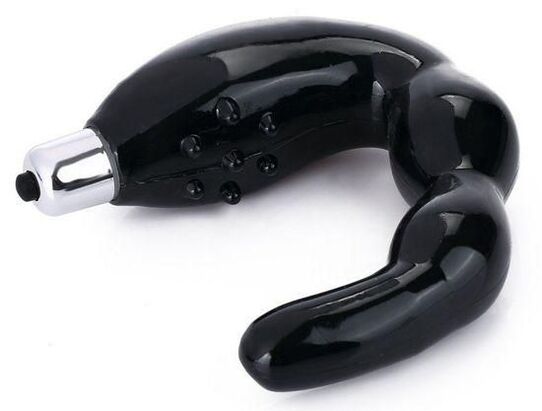
Ultrasound devices
Physiotherapy devices generate ultrasonic waves with a frequency between 800 and 3000 kHz, causing vibrations of the particles (cellular micromassage). The impact is carried out in constant or pulsed mode.The effect of ultrasound on prostate tissue:
- Improve the condition of the cell walls, increasing vascular permeability (therefore, in case of acute inflammation of the prostate with the formation of pockets of infected fluid, the procedure is not performed).
- Stimulation of biochemical processes (fermentation, oxidation) and tissue respiration.
- An increase in the number of nucleic acids that perform a large number of functions essential for the life support of cells.
- Relieve spasms, facilitate urination.
- Prevent the formation of scars in the body of the prostate (ultrasound breaks down collagen into individual fibers).
- Block pain impulses.
- Increased activity of cellular defense mechanisms.
For prostatitisultrasound is used as a transport agent for medicinal substances(hydrocortisone, antibiotics)to prostatic tissue– rectal and urethral phonophoresis. To perform the procedure, the patient must assume a knee-elbow position. You must first rinse the rectum with a rubber bulb. The rectal emitter is inserted to a depth of 8-10 cm and the drugs in the form of an emulsion are directly delivered through it. With urethral phonophoresis the therapeutic solution is introduced into a radiator inserted into the urethra. The emission nozzle is pre-lubricated with a contact substance. The procedure takes 15-20 minutes. For prostatitis, 6 to 8 sessions are performed every other day.
Exposure to ultrasound is recommended in case of scar tissue alterations, parenchymal prostatitis (with purulent secretion). Optimal results are obtained when exposed to waves with a power of 0. 3-0. 4 W/cm2in pulse mode. An increase in potency can lead to urinary disorders and exacerbation of chronic prostatitis.
Laser devices
A laser is a device for generating a concentrated stream of light particles. Photons of light penetrate through the skin into the prostate tissue and are distributed along the bloodstream. Essentially the effect is similar to the blue lamp treatment, but the infrared radiation has a greater penetrating power and has no heating effect.Under the influence of the beam, blood circulation in the prostate tissue is activated, pain and swelling decrease.
Irradiation is carried out using a contact or non-contact method. Types of emitters: rectal, transdermal and acupuncture (points on the chest, forehead, lower back, sacrum are illuminated). The intrarectal procedure takes up to two minutes. The course will require approximately 10 irradiations. In most patients, prostate pain disappears after the second session..
Popular household appliances for home use
Home portable devices for the treatment of prostatitis are generally less functional than professional ones, but are very suitable as maintenance and prevention therapy. You can buy them in pharmacies or on the manufacturers' websites.
It should be noted that the use of household appliances implies their regular hygienic maintenance. Rectal sensors should be washed with soap and disinfected with chlorhexidine solution. It is recommended to wear a condom before use.
Device with electrodes
It consists of a control unit with two connected electrodes: a physiotherapeutic one, which is inserted into the rectum, and a passive one, fixed in the lower abdomen.
It affects the prostate in three directions:
- Stimulation with pulsed currents to improve blood circulation.
- Massage with low frequency mechanical vibrations to activate venous outflow, dilate the arteries and improve the nutrition of the gland.
- Irradiation with magnetic field to relieve swelling and inflammation.
All modes of this device can be used separately.
Darsonval
Darsonval is a class of devices that generate currents of low intensity and high frequency. Externally similar to electric toothbrushes.
Special electrode attachments are provided to treat various areas. For prostatitis, a large or small rectal one is used, which can be purchased separately and are inexpensive.
Magnetotherapeutic device
The device consists of a power supply to which a strip of four magnetic emitters (inductor coils) is connected. There is no rectal probe.
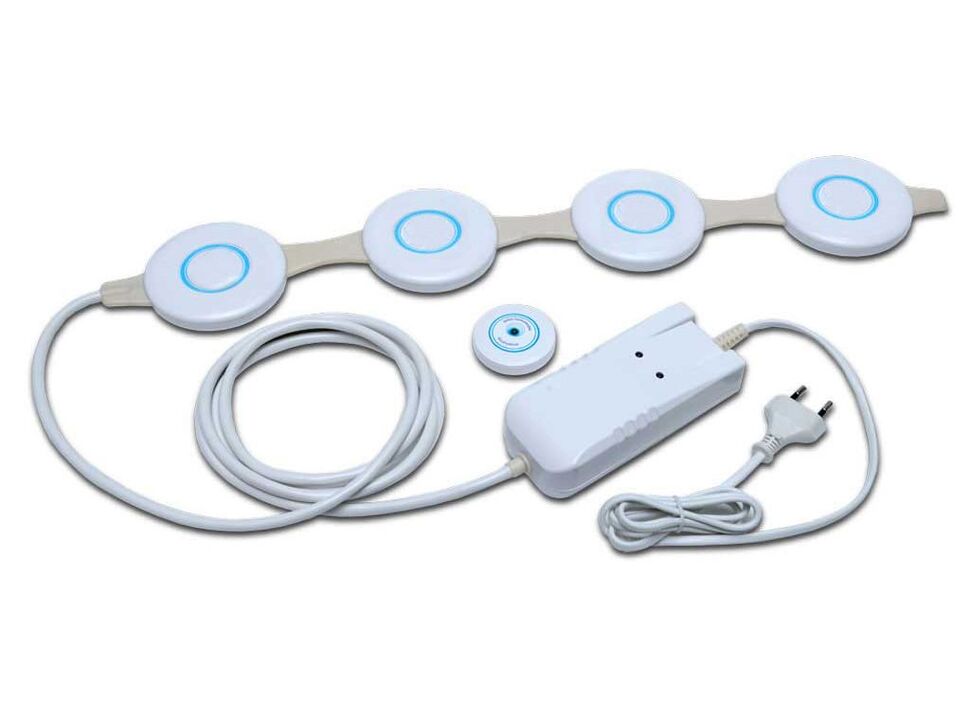
The circulating magnetic field penetrates to a depth of 8 cm, so to influence the prostate, coils can be placed both on the abdomen and in the perineum (from the scrotum to the anus).
Thermal and vibrating device
Provides thermal, vibrational and magnetic (pulsed field) effects on the prostate. It consists of a wave generator and a rectal probe. The unit has only one button ("start") and two indicator lights.
Electromagnetic device
Urological device for electromagnetic influence. It consists of a lightweight control unit with an anatomically shaped rectal probe. It has a combined effect on the prostate:
- Thermal;
- Irradiation with magnetic waves;
- Vibration (massage).
Vacuum device
The device works with vacuum and traveling magnetic waves. It consists of a control unit and a vacuum chamber into which the penis is inserted. The procedures effectively activate blood flow to the penis and prostate.
The device works in two-minute cycles, during which the pressure inside the balloon alternately increases and decreases. It has anti-edematous, anti-inflammatory and analgesic effects.
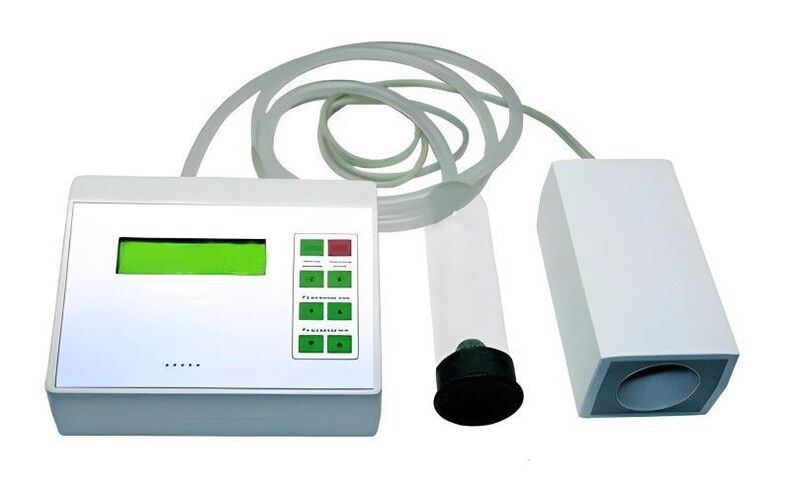
Vibroacoustic device
Portable vibroacoustic device, consisting of a control unit and two emitters. According to the manufacturer's information, under the influence of the waves, the vibrations of the walls of the capillaries increase, which helps to activate lymphatic and blood circulation.
For physiotherapy rooms
On an outpatient basis, physiotherapeutic effects on the prostate are carried out using professional multifunctional devices. They cost many orders of magnitude more than homemade ones, but the results are noticeable after just a few procedures.
High frequency electromagnetic device
Physiotherapy device that uses a high frequency electromagnetic field (microwave decimeter waves). There are all necessary registration documents, conclusions and certificates. The package includes several emitters, including a rectal one.
Laser physiotherapy complex
Laser physiotherapy complex - a device for vibrational-laser-magnetic therapy (VLMT),intended for professional use in medical institutions. Equipment:
- Base unit (three channels).
- Vibromagnetic laser head.
- Three laser heads.
- Nozzle set.
- Book on laser therapy in urology.
- A vacuum massage device with a flask and a laser-emitting head (for treating erectile dysfunction using LOD therapy).
Electrolaser device
Electrolaser devicehas a three-way effect on the prostate:
- Irradiation with four-wave laser radiation (red, infrared types IR-1, IR-2).
- Stimulation with bipolar electrical impulses (medicinal electrophoresis, transcutaneous electrical neurostimulation).
- Magnetic wave radiation (the kit includes a mirror attachment for percutaneous treatment of the prostate).
Equipped with transrectal and urethral probes. The impact parameters are selected individually, the waves are synchronized with the patient's pulse. The device is controlled by a PC or remote control.
Vacuum phototherapy device
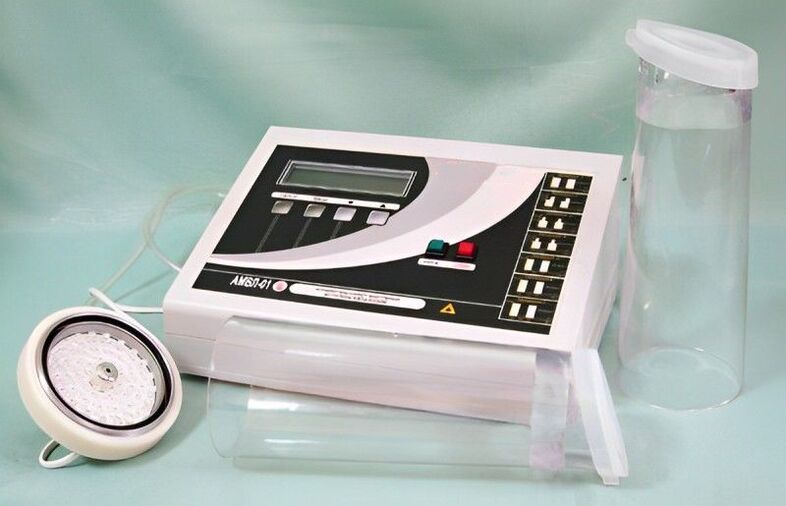
The device is a vacuum phototherapeutic penile massager. Designed to improve trophism (blood flow and metabolic processes) of the penis and prostate. It belongs to the professional class, but can also be used at home. It works in two ways:
- Local decompression (dilation of the vessels of the penis due to the vacuum created in the flask);
- Irradiation with LED matrix (phototherapy, quasi-monochromatic radiation).
The device is compatible with a PC, has 15 built-in programs, but you can simulate individual ones.
Hardware and software complex
Professional hardware and software complex, with the help of whichit is possible to influence the body with electric, laser, magnetic radiation and colored pulses. For prostate irradiation, a rectal magnetic laser intracavitary emitter with electrical stimulation function and a plate electrode positioned on the lower abdomen are provided.
The device is mass-produced, used by medical institutions and occupies a leading position in the ranking of physiotherapy medical devices.
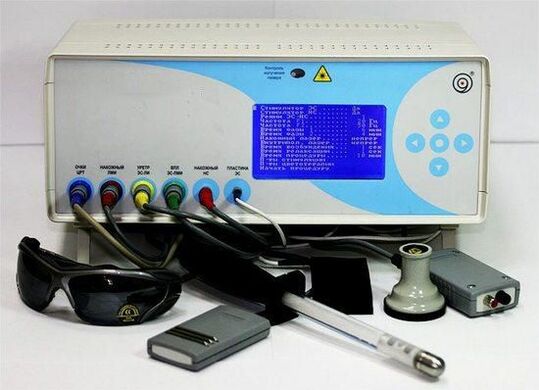
Light therapy lamp
A lamp is a device for conducting light therapy sessions. The device is available in various modifications.The polarized polychromatic light has a delicate effect on the prostate tissue, stimulating its regeneration by activating biological processes (the light hits the intracellular molecules). The procedures relieve pain and reduce inflammation.
How the procedure takes place: the light of the lamp is directed onto the area of the lower abdomen, previously cleaned with a special liquid, and then onto the perineum. The exposure time is 5 minutes. There may be multiple heating points. For long-lasting relief from prostatitis symptoms, 10 sessions are sufficient.
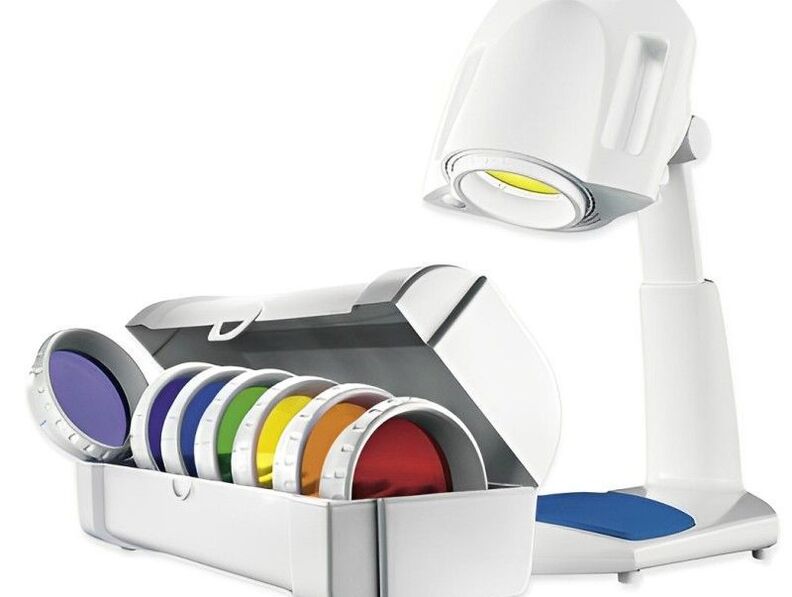
Questionable devices
In various sources there are advertisements for devices without certificates and it is very difficult to find information about the manufacturer. Numerous retailers pretend to be the manufacturer and prices vary significantly. In particular, some of them are missing from the register.
Physiotherapeutic devices for the treatment of prostatitis are not cheap.You should buy products from manufacturers who do not hide their contacts, do not publish scanned certificates on devices and provide a guarantee.
Conclusion
Physiotherapeutic devices do not replace pharmacological treatment, but complement it. Home sessions should be carried out strictly according to the instructions, without fanaticism. Otherwise, you can provoke an exacerbation of prostatitis. You shouldn't expect much from household appliances. Producers often protect themselves by limiting the potency of their exposure. For example, not all laser devices use lasers. In most cases they have been replaced by cheap LED emitters. The result of the procedures also depends on the patient's condition, his age and even his psychological mood.


























